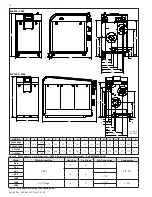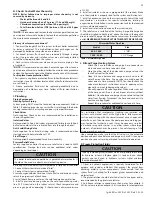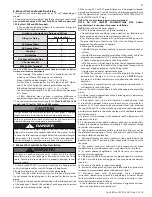
lp-666 Rev. 003 Rel. 001 Date 2.25.20
10
D. Clearances for Service Access
NOTE:
If you do not provide the minimum clearances shown in Figure
6 it might not be possible to service the boiler without removing it
from the space.
NOTE:
A combustible door or removable panel is acceptable front
clearance.
NOTE:
In multiple boiler installations, ensure an 18” minimum clearance
is maintained between boilers.
WARNING
!
The space must be provided with combustion / ventilation air
openings correctly sized for all other appliances located in the same
space as the boiler. The boiler cover must be securely fastened to
prevent the boiler from drawing air from the boiler room. This is
particularly important if the boiler is in a room with other appliances.
Failure to comply with the above warnings could result in substantial
property damage, severe personal injury, or death.
24”
6"
10/31/18
LP-666-M
24"
24"
18"
Figure 6 - Recommended Service Clearances
All boilers eventually leak. Locate the boiler where any leakage from
the relief valve, related piping, tank, or connections will not result
in damage to surrounding areas or lower floors of the building. Any
boiler should be installed in such a manner that if it should leak the
resulting flow of water will not cause damage to the area in which it
is installed. If the boiler is installed in a location where a leak could
cause damage, it is required to provide containment measures.
Such measures include but are not limited to: a properly sized drain
pan installed beneath the boiler and piped to an open drain line, or
installing the boiler on a concrete floor pitched to a free flowing drain.
Failure to provide containment measures is the sole responsibility of
the owner and/or installer. Leakage damages ARE NOT covered by
warranty.
In addition, water leak detection devices and automatic water shutoff
valves are readily available at plumbing supply houses. IT IS HIGHLY
RECOMMENDED BY THE MANUFACTURER TO INSTALL WATER LEAK
DETECTION DEVICES AND AUTOMATIC SHUTOFF VALVES IN ANY
BOILER INSTALLATION WHERE A LEAKAGE OF WATER COULD RESULT
IN PROPERTY DAMAGES.
CAUTION
E. Residential Garage and Closet Installations
Check with your local Authority Having Jurisdiction for
requirements when installing the boiler in a garage or closet.
Please read the entire manual before attempting installation.
Failure to properly take factors such as venting, piping, condensate
removal, and wiring into account before installation could result in
wasted time, money, and possible property damage and personal
injury.
CAUTION
Precautions
If the boiler is located in a residential garage, per ANSI Z223.1:
• Install the boiler burner and ignition devices a minimum of
18” above the floor of the garage. This will ensure the burner
and ignition devices are well off the floor.
• When raising the boiler ensure the entire bottom and fully
filled weight of the boiler are fully supported.
• Locate or protect the boiler so it cannot be damaged by a
moving vehicle.
WARNING
!
The space must be provided with correctly sized combustion/
ventilation air openings for all other appliances located in the
space with the boiler. For power venting installations using room
air for combustion, refer to the venting section, this manual, for
descriptions of confined and unconfined spaces. Do not install
the boiler in an attic. Failure to comply with these warnings could
result in substantial property damage, severe personal injury, or
death.
F. Exhaust Vent and Intake Pipe
The boiler is rated ANSI Z21.13 Category IV (pressurized vent, likely
to form condensate in the vent) and requires a special vent system
designed for pressurized venting.
NOTE: The venting options described here (and further detailed
in the Venting section, this manual) are the lone venting options
approved for this boiler. Failure to vent the boiler in accordance
with the provided venting instructions will void the warranty.
DANGER
!
Failure to vent the boiler properly will result in serious personal
injury or death.
WARNING
!
Do not attempt to vent this boiler by any means other than those
described in this manual. Doing so will void the warranty and may
result in severe personal injury or death.
The exhaust discharged by this boiler may be very hot. Avoid
touching or other direct contact with the exhaust gases of the vent
termination assembly. Doing so could result in severe personal
injury or death.
Vents must be properly supported. Boiler exhaust and intake
connections are not designed to carry heavy weight. Vent support
brackets must be within 1’ of the boiler and the balance at 4’
intervals. Boiler must be readily accessible for visual inspection
for first 3’ from the boiler. Failure to properly support vents could
result in property damage, severe personal injury, or death.
1. Direct Vent of Exhaust and Intake
If installing a direct vent option, combustion air must be drawn
from the outdoors directly into the boiler intake and exhaust must
terminate outdoors. There are three basic direct vent options
detailed in this manual: 1. Side Wall Venting, 2. Roof Venting, and 3.
Unbalanced Venting.
Be sure to locate the boiler such that the exhaust vent and intake
piping can be routed through the building and properly terminated.











































